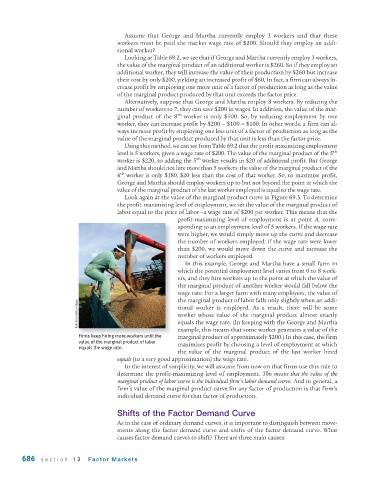Page 728 - Krugmans Economics for AP Text Book_Neat
P. 728
Assume that George and Martha currently employ 3 workers and that these
workers must be paid the market wage rate of $200. Should they employ an addi-
tional worker?
Looking at Table 69.2, we see that if George and Martha currently employ 3 workers,
the value of the marginal product of an additional worker is $260. So if they employ an
additional worker, they will increase the value of their production by $260 but increase
their cost by only $200, yielding an increased profit of $60. In fact, a firm can always in-
crease profit by employing one more unit of a factor of production as long as the value
of the marginal product produced by that unit exceeds the factor price.
Alternatively, suppose that George and Martha employ 8 workers. By reducing the
number of workers to 7, they can save $200 in wages. In addition, the value of the mar-
ginal product of the 8 th worker is only $100. So, by reducing employment by one
worker, they can increase profit by $200 − $100 = $100. In other words, a firm can al-
ways increase profit by employing one less unit of a factor of production as long as the
value of the marginal product produced by that unit is less than the factor price.
Using this method, we can see from Table 69.2 that the profit-maximizing employment
level is 5 workers, given a wage rate of $200. The value of the marginal product of the 5 th
th
worker is $220, so adding the 5 worker results in $20 of additional profit. But George
and Martha should not hire more than 5 workers: the value of the marginal product of the
th
6 worker is only $180, $20 less than the cost of that worker. So, to maximize profit,
George and Martha should employ workers up to but not beyond the point at which the
value of the marginal product of the last worker employed is equal to the wage rate.
Look again at the value of the marginal product curve in Figure 69.3. To determine
the profit-maximizing level of employment, we set the value of the marginal product of
labor equal to the price of labor—a wage rate of $200 per worker. This means that the
profit-maximizing level of employment is at point A, corre-
sponding to an employment level of 5 workers. If the wage rate
were higher, we would simply move up the curve and decrease
the number of workers employed: if the wage rate were lower
than $200, we would move down the curve and increase the
number of workers employed.
In this example, George and Martha have a small farm in
which the potential employment level varies from 0 to 8 work-
ers, and they hire workers up to the point at which the value of
the marginal product of another worker would fall below the
wage rate. For a larger farm with many employees, the value of
the marginal product of labor falls only slightly when an addi-
Koki lino/Getty Images tional worker is employed. As a result, there will be some
worker whose value of the marginal product almost exactly
equals the wage rate. (In keeping with the George and Martha
example, this means that some worker generates a value of the
Firms keep hiring more workers until the marginal product of approximately $200.) In this case, the firm
value of the marginal product of labor maximizes profit by choosing a level of employment at which
equals the wage rate.
the value of the marginal product of the last worker hired
equals (to a very good approximation) the wage rate.
In the interest of simplicity, we will assume from now on that firms use this rule to
determine the profit-maximizing level of employment. This means that the value of the
marginal product of labor curve is the individual firm’s labor demand curve. And in general, a
firm’s value of the marginal product curve for any factor of production is that firm’s
individual demand curve for that factor of production.
Shifts of the Factor Demand Curve
As in the case of ordinary demand curves, it is important to distinguish between move-
ments along the factor demand curve and shifts of the factor demand curve. What
causes factor demand curves to shift? There are three main causes:
686 section 13 Factor Markets

